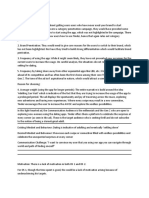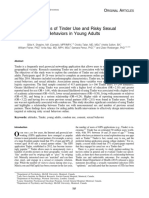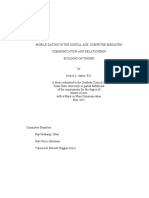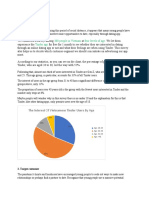CASE STUDY- TINDER
The world has shifted from traditional means of interaction to digital means with the help of
internet and smart phones. Technology has given people more opportunities to date, people got
more choices now. Tinder capitalized on smart algorithm of user friendly interface and
interactive design. Simplicity lies in a sophisticated algorithm, which encompasses geo-location
data and machine learning technology. The app leverages data from social networks.
Tinder mastered on word of mouth marketing to build its brand. Tinder focused first on
American college sorority groups to encourage young women to join the app and convinced each
sorority to download the app. Social networks like Facebook and Instagram set a path for
exponential growth.
Tinder has been able to get 40 million + downloads in a relatively short span of time through its
user friendly and interactive design app. The app leverages data from social networks, showing
you possible love interests from your friends’ social networks, as well as suitors from the local
area Tinder has a variable rewards element, which encourages people to keep ‘playing’ with the
app. The gamified experience of the app let people use the app and become addictive. Firstly,
tinder was only downloaded on iOS but they later let android users to use the app, and it was a
win. They also give the access of their app to android users. Moreover, tinder used ephemeral
contents that are one of the most intriguing types of content in recent years. The company also
acquires its competitors to create unrivaled user experience.
OKCupid, Plenty of Fish, and Hinge were Tinder’s main competitors, but they were all acquired
by Tinder’s parent company, Match group. Bumble was the main competing product launched
by former tinder’s employee. The unique selling point of Bumble is that only female users can
�initiate the conversation after a match occurs. Bumble was experiencing 70% year-on-year on
growth, turning the company into a tech unicorn worth over $1 billion in just three years.
Bumble remained the sole threat to Tinder in an increasingly monopolized industry.
I think Tinder was a huge success. Initially, there was lack of dating opportunities, Tinder
realized this gap and capitalized on this opportunity while fulfilling customer’s preferences.
They done their marketing strategically and was able to become a market leader through above
mentioned tactics and strategies. They remained a monopolized industry through acquiring
competitors. They gave their customers user friendly experience, they played with psychic of
their consumers and they knew well, that how to make their customers addictive and satisfied.
They evolved their app according to customer’s need, while integrating new features, giving easy
access of its app to all users.
No doubt, tinder was a success and market leader but it got negative consequences on society
and people. Online dating is cruel now, as there’s prevalence of rudeness on these apps and a
wall of relative anonymity behind which people hide. These things turn off a person and they are
more likely to prefer traditional way of dating. Tinder can come up with a brand extension where
tinder could use technology in a way, which could lessen the anonymity of a person and cross
check the authenticity of users. They should incur features of report and blocking, where people
could report the spam or unusual content. They should not let deceived people to be on such
platform once they are reported by others. They should strengthen the means of privacy on the
app so that people could feel more confidential about their pictures and chats.
























































































